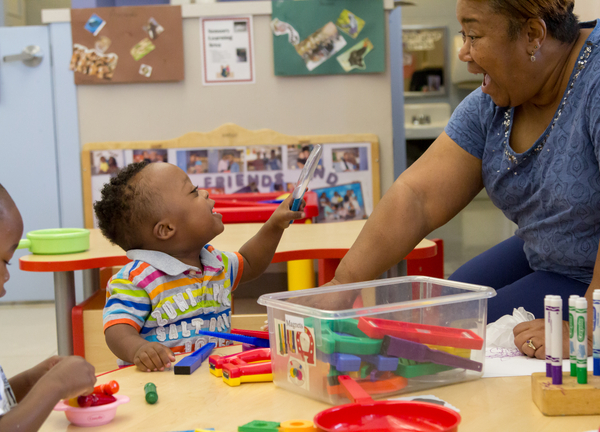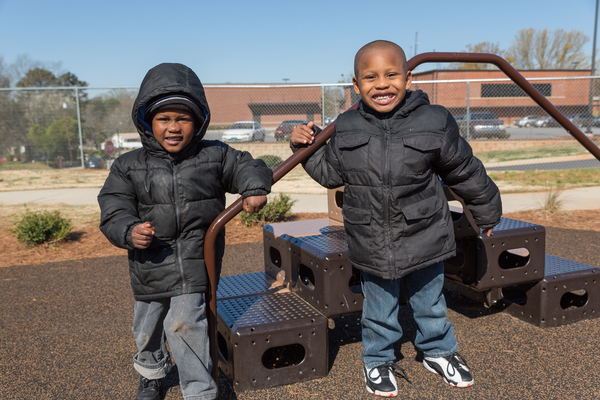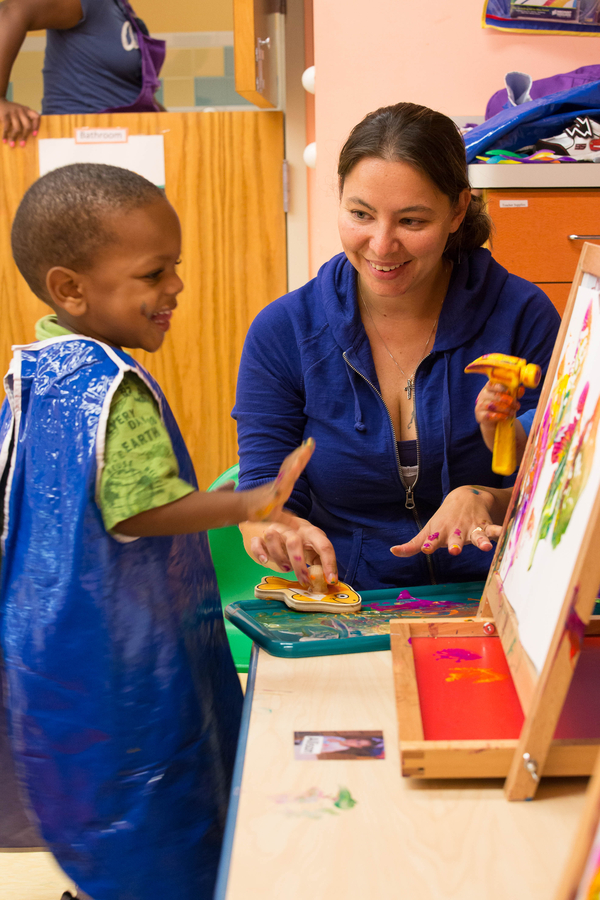 Healthy, secure, responsive, and nurturing adult-child relationships are a necessary foundation for lifelong development and learning. From birth, these kinds of relationships shape a child’s growing sense of identity and belonging within a community and give them the confidence to engage in learning. For African American boys, this includes adults appreciating and incorporating their interests and ways of learning. These positive adult-child relationships allow African American boys to feel safe and engage as learners in ways that work best for them.
Healthy, secure, responsive, and nurturing adult-child relationships are a necessary foundation for lifelong development and learning. From birth, these kinds of relationships shape a child’s growing sense of identity and belonging within a community and give them the confidence to engage in learning. For African American boys, this includes adults appreciating and incorporating their interests and ways of learning. These positive adult-child relationships allow African American boys to feel safe and engage as learners in ways that work best for them.
The absence of nurturing relationships, especially by an early caregiver, can affect a child’s ability to form healthy attachments. Implicit bias may influence the reciprocal relationship between a child and a caregiver. When boys and young men of color were asked about what aided their success and achievement, they often replied it was the educators who cared about them as people.
Why Building Relationships Matters
- A child’s relationships with caring families, education staff (e.g., teachers, family child care providers, home visitors), and other adults are very important. Responsive and supportive interactions with adults are vital to children’s learning. For African American boys, however, bias and inequities get in the way of relationship-building opportunities with both adults and their peers. African American boys deserve nurturing, responsive, and consistent care that creates safe environments where they feel secure and valued. In these environments, young African American boys can participate fully in learning experiences.
- African American boys learn about Black identity and self-worth from the most important people in their lives, including their educators. By recognizing and working against the negative impacts caused by bias — based on both race and gender — and structural racism, education staff can help young African American boys feel seen, heard, and valued.
- A large, national sample of 4-year-olds in pre-K learning environments found that how educators interacted with children while teaching predicted how the children performed in school and how their language skills developed. The same study found that how educators emotionally interacted with preschoolers predicted the children’s social skills development.
- African American boys make up nearly 10% of preschool enrollment, but they account for about 34% of preschoolers who receive one or more out-of-school suspensions. Suspensions and expulsions can disrupt the development of a positive relationship between boys and their educators.
- Relationships that nurture the development of young African American boys are needed to change the negative conditions that hinder development of a sense of identity, belonging, readiness for learning — and lifelong success.

Reflect
Beginning at birth, young children develop their identities in the context of family and community relationships. A first step in building relationships with African American boys is reflecting on the beliefs and thoughts you might have, also called perceived strengths and perceived deficits.
Complete the following steps to brainstorm your beliefs and thoughts about African American boys:
On a piece of paper, write down everything that comes to mind when you think of African American boys. Categorize each item as “perceived strengths” or “perceived deficits.”
Review your list and consider the following reflection questions:
- What messages were shared in your family and community about African American boys and men?
- How are these beliefs different or similar when compared to other children you work with?
- Do you include all children in learning activities and leadership opportunities?
- How are the perceived strengths and deficits confirmed through materials, activities, or in the design of the environment where African American boys play and learn?
- How do these perceived strengths and deficits affect how you partner with families?
- Are you open and welcoming to fathers, inviting them into the learning process and environment? How? What are some examples?
- How do these perceived strengths and deficits influence how you engage with families of African American boys during home visits or socialization groups?
- What behaviors do you think of as challenging in African American boys? Why?
- How are the beliefs you hold influenced by local, state, or federal policies?
- How can the perceived deficits be viewed positively as strengths?
- How might the beliefs you hold affect building relationships with African American boys?

Practices that Promote Building Relationships
Examine the physical space of your classroom, family child care home, or group socialization area and plan changes that can increase engagement and a sense of belonging.
- Consider how your environment supports the learning goals of African American boys in your care. How do your spaces support child-directed activities? How does your space encourage African American boys to be leaders?
- Give materials that reflect the family and culture of the children, including reading materials featuring African American boys. Children are inspired by the images they see in their environment. Include positive images of African American boys and men in a variety of roles.
Create a climate of trust by showing each boy he is seen, heard, and valued.
- Get to know the child by asking the family about likes, dislikes, ways to be soothed, and how the child learns best.
- Create opportunities for African American boys to play, share ideas, pause to wonder, or ask questions. How often are African American boys positively recognized for their behavior? How often is their behavior redirected or scolded?
Set an intention and plan to build relationships with African American boys in your care.
- Try the 2x10 strategy. Have conversations or play with one or more African American boys for two minutes on 10 consecutive days. Select a child you don’t know well, or you’ve been having difficulty working with positively. At the end of 10 days, describe your relationship with the child. Did the strategy improve your relationship?
Plan activities and experiences that allow children to express what makes them unique:
- Sing songs to infants and toddlers that celebrate membership in the group and uniqueness. Use the names of each child in verses.
- Include mirror time with infants to allow them to see themselves and view their unique characteristics.
- Ask children about their interests and use those interests to plan learning experiences. Watch and observe infants and toddlers during play to learn about interests that you can include more often.
- Share positive feedback with all children. Each child should feel proud of who they are. For example, if you find yourself complimenting only some children and some families, ask yourself why.
- Show joy in interacting with African American boys and their families.
- Offer materials and activities that allow African American boys to participate, succeed, and feel challenged about building new skills and knowledge.
Support the relationship between a child and their family, which could include parents, grandparents, extended family members, or foster parents:
- Keep in close touch with families to exchange information about the child’s interests, successes, and challenges.
- Create opportunities for male role models to join and take part in learning activities.
Try It!
Download the Try It! worksheet and choose one practice to focus on for a month. Use the prompts in the worksheet to thoughtfully plan how you will use the practice. The worksheet includes prompts for reflection after using the practice for one month.

Deepen Your Learning
Use these Tips for Teachers handouts to learn more about strengthening relationships with children and building a supportive community:
Connections to Head Start Standards, Frameworks, and Principles
Many of the Head Start practices outlined below support the school readiness and success of young African American boys. Keep your learning setting in mind when considering how you already implement these practices and how you can more closely align to improve your existing teaching practices.
Head Start Program Performance Standards
- Purpose, 45 CFR §1302.30
- Teaching and the learning environment, 45 CFR §1302.31(b)(1)(i)
- Parent and family engagement in education and child development services, 45 CFR §1302.34(a)
- Education in home-based programs, 45 CFR §1302.35(a)
Head Start Early Learning Outcomes Framework
Learning and development goals in the ELOF Social and Emotional domain can help in building relationships with African American boys. Here are some example practices from the Social and Emotional Effective Practice Guide that are especially beneficial:
- Relationships with Adults: Show warmth and affection to children by smiling, laughing, showing sensitive caring, and using gentle, nurturing touch.
- Relationships with Other Children: Lead games that teach children how to cooperate, take turns, and accomplish a shared goal.
- Sense of Identity and Belonging: Offer meaningful, specific praise for efforts and accomplishments.
Multicultural Principles for Early Childhood Leaders
Implementation of the multicultural principles honors the cultural diversity of children, families, and communities served in Head Start programs.
Read more:
Resource Type: Article
National Centers: Early Childhood Development, Teaching and Learning
Last Updated: February 6, 2024